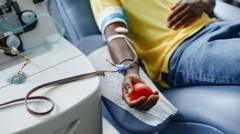The Australian government announced that rules prohibiting sexually active gay and bisexual men from donating blood and plasma will be rescinded as of July 14, a decision hailed as a significant step in promoting equality and inclusivity within the healthcare system. This shift aligns Australia with recent changes in the UK and US that aim to minimize stigma against LGBTQIA+ communities while ensuring blood safety.
Previously, any men or transgender women who had sexual contact with men within the last three months were disqualified from donating blood, in addition to sex workers and women with bisexual partners. Under the revised regulations, those in a sexual relationship lasting six months or longer will be eligible to donate blood, regardless of their gender or sexuality.
The national blood donation service, Lifeblood, reports that the updated rules will not only eliminate past restrictions but also broaden the potential donor pool by approximately 625,000 people, greatly enhancing the capacity for blood donation across the nation. This decision was applauded by activists like Rodney Croome of the Let Us Give campaign, who emphasized that "Australian lives will be saved by this overdue and important decision."
Lifeblood's Chief Medical Officer, Jo Pink, emphasized the significance of the change, acknowledging the emotional toll the previous rules imposed on the LGBTQIA+ community. The revised guidelines state that potential donors will no longer be asked if they have had sex with men in the past three months. Instead, they will need to disclose if they have engaged in anal sex with new or multiple partners, with a three-month wait period for those answering affirmatively, though plasma donation will still be permitted.
While the changes have stirred excitement, some advocates like Sharon Dane note that the new regulations, particularly concerning whole blood donations, may still fall short of best practices observed in countries such as Canada and the UK, which have simplified their guidelines substantially.
Despite these concerns, Lifeblood is optimistic that the alterations will meet the growing global demand for plasma and adequately enhance the nation's blood supply system. The pathway for donation is set to continue evolving, with a new approach to blood donations to be launched in 2026.
Previously, any men or transgender women who had sexual contact with men within the last three months were disqualified from donating blood, in addition to sex workers and women with bisexual partners. Under the revised regulations, those in a sexual relationship lasting six months or longer will be eligible to donate blood, regardless of their gender or sexuality.
The national blood donation service, Lifeblood, reports that the updated rules will not only eliminate past restrictions but also broaden the potential donor pool by approximately 625,000 people, greatly enhancing the capacity for blood donation across the nation. This decision was applauded by activists like Rodney Croome of the Let Us Give campaign, who emphasized that "Australian lives will be saved by this overdue and important decision."
Lifeblood's Chief Medical Officer, Jo Pink, emphasized the significance of the change, acknowledging the emotional toll the previous rules imposed on the LGBTQIA+ community. The revised guidelines state that potential donors will no longer be asked if they have had sex with men in the past three months. Instead, they will need to disclose if they have engaged in anal sex with new or multiple partners, with a three-month wait period for those answering affirmatively, though plasma donation will still be permitted.
While the changes have stirred excitement, some advocates like Sharon Dane note that the new regulations, particularly concerning whole blood donations, may still fall short of best practices observed in countries such as Canada and the UK, which have simplified their guidelines substantially.
Despite these concerns, Lifeblood is optimistic that the alterations will meet the growing global demand for plasma and adequately enhance the nation's blood supply system. The pathway for donation is set to continue evolving, with a new approach to blood donations to be launched in 2026.





















